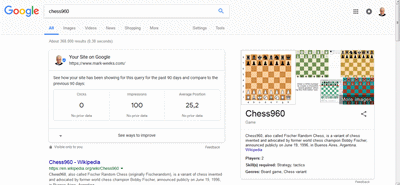https://www.mark-weeks.com/
The rest of the box says,
See how your site has been showing for this query for the past 90 days and compare to the previous 90 days:
- Clicks 0
- Impressions 100
- Average position 25,2
Each of those metrics is currently subtitled 'No prior data'. I suppose that after 90 days, some prior data will be displayed.

Google search on 'chess960'
I saw the box this week for the first time while recording my weekly look at web statistics. It's something I do to make sure that my various web resources are performing normally. If I detect an anomaly, I can act on it before it becomes a bigger problem.
The bottom of the box says, 'See ways to improve', which expands to show two pieces of advice. The first is a link to the same 'Performance' page I displayed in a blog post last month, Google Search Console; the second is to a Google page, Help people find your site on Google (support.google.com).
I don't know how many days the three metrics cover. All I know is that they weren't there a week earlier. The reason I look at chess960 search results is to track the position of this blog and of a couple of reference pages:-
I look at the first five pages of Google results and record the position of the resource. One curiosity I've noticed is that those two reference pages (both on mark-weeks.com) rarely show up in the search results at the same time. Sometimes one appears in the first five pages and the other does not appear at all; sometimes the other appears. There is no pattern to predict which one will show up. I occasionally scroll down more than five pages to see if the other one is buried deeper, but it's never there. Google search results often defy explanation.
Don't think I'm ungrateful. Thanks, Google! I'm sure the data will be useful in a Googly sort of way.
